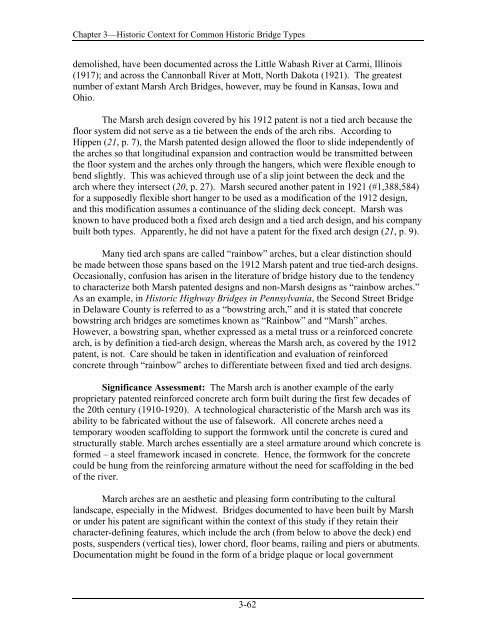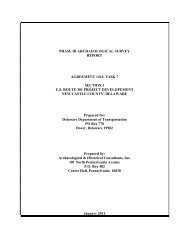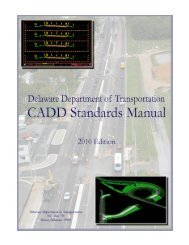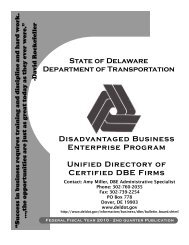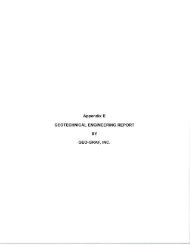Gulph Creek Stone Arch Bridge - Delaware Department of ...
Gulph Creek Stone Arch Bridge - Delaware Department of ...
Gulph Creek Stone Arch Bridge - Delaware Department of ...
Create successful ePaper yourself
Turn your PDF publications into a flip-book with our unique Google optimized e-Paper software.
Chapter 3—Historic Context for Common Historic <strong>Bridge</strong> Types<br />
demolished, have been documented across the Little Wabash River at Carmi, Illinois<br />
(1917); and across the Cannonball River at Mott, North Dakota (1921). The greatest<br />
number <strong>of</strong> extant Marsh <strong>Arch</strong> <strong>Bridge</strong>s, however, may be found in Kansas, Iowa and<br />
Ohio.<br />
The Marsh arch design covered by his 1912 patent is not a tied arch because the<br />
floor system did not serve as a tie between the ends <strong>of</strong> the arch ribs. According to<br />
Hippen (21, p. 7), the Marsh patented design allowed the floor to slide independently <strong>of</strong><br />
the arches so that longitudinal expansion and contraction would be transmitted between<br />
the floor system and the arches only through the hangers, which were flexible enough to<br />
bend slightly. This was achieved through use <strong>of</strong> a slip joint between the deck and the<br />
arch where they intersect (20, p. 27). Marsh secured another patent in 1921 (#1,388,584)<br />
for a supposedly flexible short hanger to be used as a modification <strong>of</strong> the 1912 design,<br />
and this modification assumes a continuance <strong>of</strong> the sliding deck concept. Marsh was<br />
known to have produced both a fixed arch design and a tied arch design, and his company<br />
built both types. Apparently, he did not have a patent for the fixed arch design (21, p. 9).<br />
Many tied arch spans are called “rainbow” arches, but a clear distinction should<br />
be made between those spans based on the 1912 Marsh patent and true tied-arch designs.<br />
Occasionally, confusion has arisen in the literature <strong>of</strong> bridge history due to the tendency<br />
to characterize both Marsh patented designs and non-Marsh designs as “rainbow arches.”<br />
As an example, in Historic Highway <strong>Bridge</strong>s in Pennsylvania, the Second Street <strong>Bridge</strong><br />
in <strong>Delaware</strong> County is referred to as a “bowstring arch,” and it is stated that concrete<br />
bowstring arch bridges are sometimes known as “Rainbow” and “Marsh” arches.<br />
However, a bowstring span, whether expressed as a metal truss or a reinforced concrete<br />
arch, is by definition a tied-arch design, whereas the Marsh arch, as covered by the 1912<br />
patent, is not. Care should be taken in identification and evaluation <strong>of</strong> reinforced<br />
concrete through “rainbow” arches to differentiate between fixed and tied arch designs.<br />
Significance Assessment: The Marsh arch is another example <strong>of</strong> the early<br />
proprietary patented reinforced concrete arch form built during the first few decades <strong>of</strong><br />
the 20th century (1910-1920). A technological characteristic <strong>of</strong> the Marsh arch was its<br />
ability to be fabricated without the use <strong>of</strong> falsework. All concrete arches need a<br />
temporary wooden scaffolding to support the formwork until the concrete is cured and<br />
structurally stable. March arches essentially are a steel armature around which concrete is<br />
formed – a steel framework incased in concrete. Hence, the formwork for the concrete<br />
could be hung from the reinforcing armature without the need for scaffolding in the bed<br />
<strong>of</strong> the river.<br />
March arches are an aesthetic and pleasing form contributing to the cultural<br />
landscape, especially in the Midwest. <strong>Bridge</strong>s documented to have been built by Marsh<br />
or under his patent are significant within the context <strong>of</strong> this study if they retain their<br />
character-defining features, which include the arch (from below to above the deck) end<br />
posts, suspenders (vertical ties), lower chord, floor beams, railing and piers or abutments.<br />
Documentation might be found in the form <strong>of</strong> a bridge plaque or local government<br />
3-62


